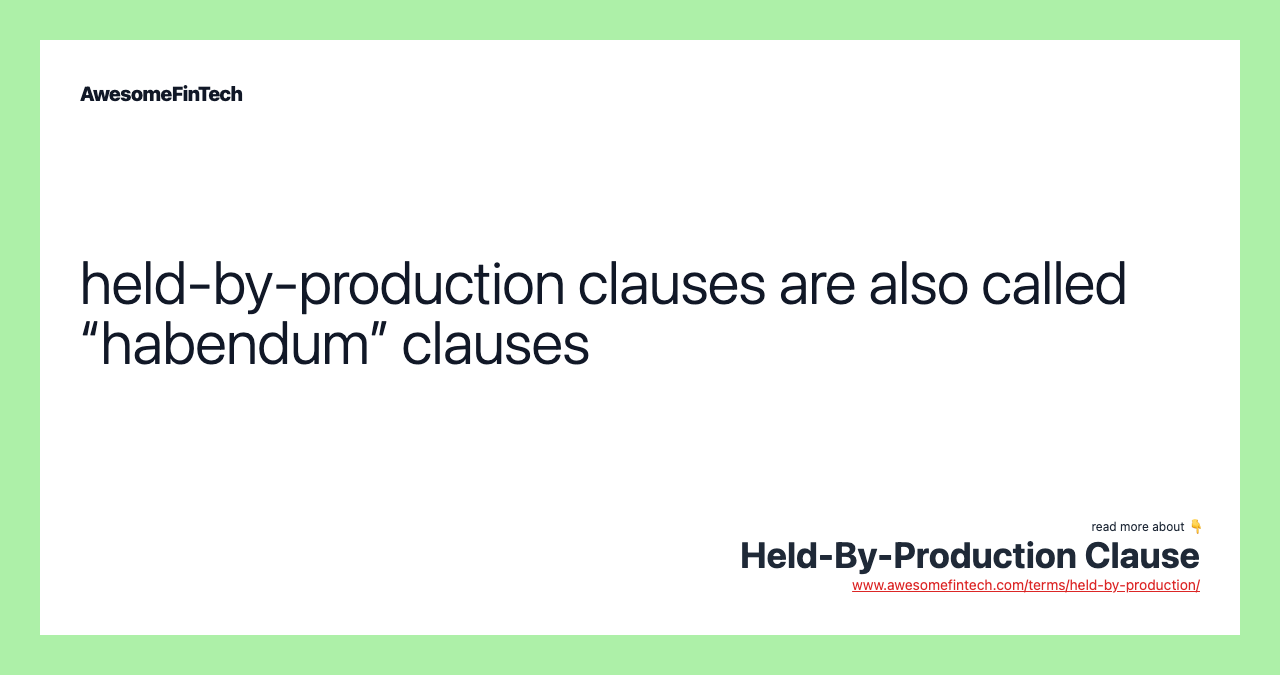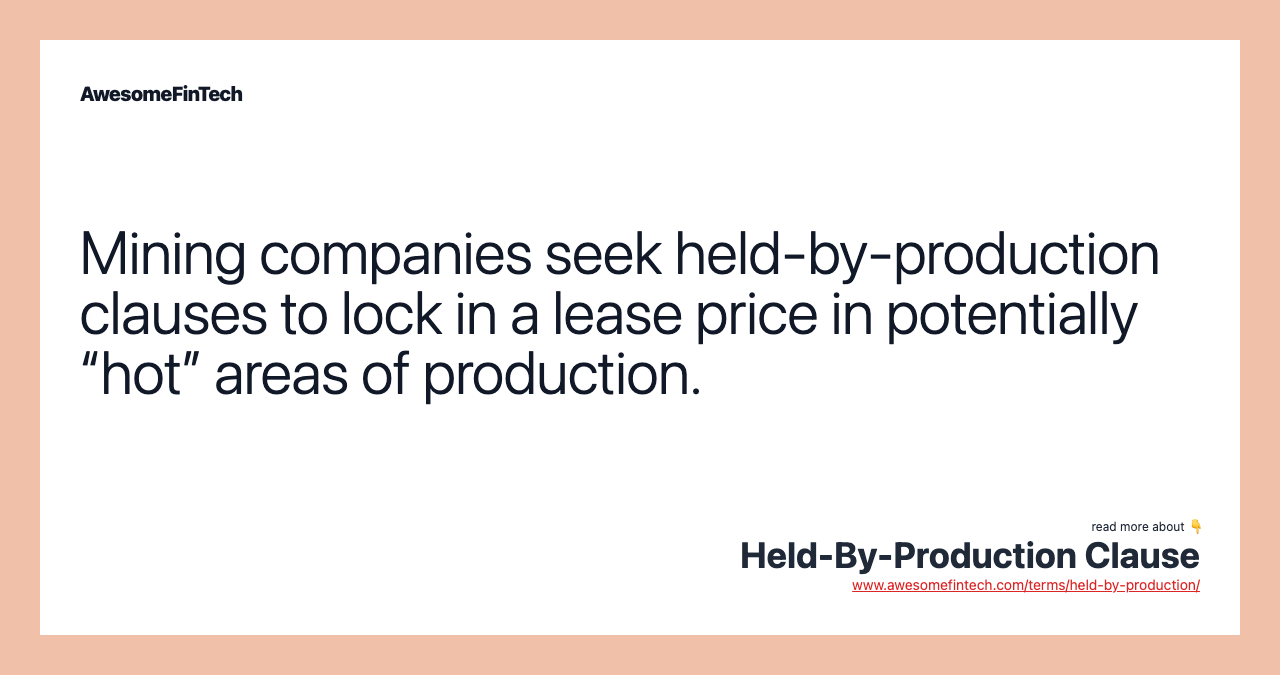Held-By-Production Clause
"Held by production" is a provision in an oil or natural gas property lease that allows the lessee, generally an energy company, to continue drilling activities on the property as long as it is economically producing a minimum amount of oil or gas. Held by production is a type of mineral rights lease for the oil company, where the oil company operating the production facilities on another owner's land has a right to access the minerals or reserves on that land beyond the originally agreed lease term. Held-by-production clauses allow miners for oil, gas and minerals extend their land leases after they expire as long as the mines are still productive. held-by-production clauses are also called “habendum” clauses According to the Energy Mineral and Law Foundation, the use of held-by-production clauses increased dramatically after Range Resources, an independent natural gas company, began drilling extremely profitable horizontal, hydraulic fracturing wells in 2007 in Washington County, Pennsylvania. When the industry became aware of Range’s successes with the new technique, other companies began leasing property for development at skyrocketing prices. The held-by-production provision enables energy companies to avoid renegotiating leases upon expiry of the initial (primary) term and allows them to operate under a secondary term for the entire economic life cycle of an oil or gas field.

What is a Held-By-Production Clause?
"Held by production" is a provision in an oil or natural gas property lease that allows the lessee, generally an energy company, to continue drilling activities on the property as long as it is economically producing a minimum amount of oil or gas. The held-by-production provision thereby extends the lessee's right to operate the property beyond the initial lease term. This provision is also a feature of mineral property leases.



How a Held-By-Production Clause Works
The held-by-production provision enables energy companies to avoid renegotiating leases upon expiry of the initial (primary) term and allows them to operate under a secondary term for the entire economic life cycle of an oil or gas field. This results in considerable savings to them, particularly in geographical areas that have become "hot" due to prolific output from oil and gas wells. With property prices in such areas generally on an upward trend, leaseholders would naturally demand significantly higher prices to renegotiate leases.
Habendum Clause
According to the law firm Holland & Hart, the held-by-production clause in a lease can also be called the habendum clause. A habendum clause in an oil and gas lease typically contains two separate terms, the primary term and the secondary term. The primary term is a fixed time period and expires at some point in the future. The time period under the secondary term is indefinite. So long as oil and gas are produced, the lease remains in effect.
Mineral Rights Lease
Held by production is a type of mineral rights lease for the oil company, where the oil company operating the production facilities on another owner's land has a right to access the minerals or reserves on that land beyond the originally agreed lease term.
This issue is particularly important in the wake of the shale oil boom in the U.S. and Canada. Land with these shale resources can command considerable value. For some landowners, however, the shale boom is less welcome news because they have been cut out of the leasing windfall by held-by-production clauses.
Under held-by-production clauses, oil companies can retain control of the entire leasehold as long as there is at least one well producing a "minimum paying quantity" of oil or gas on the property. (Minimum paying quantities are generally defined as a value of oil production that exceeds operating costs.) This can create considerable conflict between landowners and the oil and gas companies operating there.
Examples of a Held-By-Production Clause
According to the Energy Mineral and Law Foundation, the use of held-by-production clauses increased dramatically after Range Resources, an independent natural gas company, began drilling extremely profitable horizontal, hydraulic fracturing wells in 2007 in Washington County, Pennsylvania.
When the industry became aware of Range’s successes with the new technique, other companies began leasing property for development at skyrocketing prices. The “competition for acreage caused lease prices to escalate from historical prices of $1 per acre to $500 per acre, then to $1,000 per acre, and then to as much as $10,000 and more per acre.”
In order to protect their investments from price rises, companies sought held-by-production clauses in their new leases, and in some cases they looked to buy old leases for poorly performing wells and use the new fracking technology to increase profits.
Related terms:
Farmout
A farmout is the assignment of part or all of an oil, natural gas or mineral interest to a third party for development. read more
Habendum Clause
The habendum clause is legal language that is included in contracts dealing with property transfer, setting the rights, restriction and term. read more
Initial Production Rate
The initial production rate measures how many barrels of oil a day a new oil well produces, and is used as a proxy for an oil well’s future productivity. read more
Lease
A lease is a legal document outlining the terms under which one party agrees to rent property from another party. read more
Lessee
A lessee is a person who rents land or property and must follow restrictions and guidelines set by a lease agreement. read more
Net Acres
Net acres represent an oil company's ownership stake in shared projects in addition to acres leased directly by the company for exploration and production. read more
Non-Hydraulic Fracturing
Non-hydraulic fracturing, also known as dry fracturing, is a method for extracting oil that does not rely on the use of water in the drilling process. read more